As a local guide with over a decade of experience, one of the most frequent questions I encounter from visitors revolves around the vibrant and diverse culinary landscape of my country. People are naturally curious: What Do People Eat In Vietnam on a daily basis? Is the food healthy? How safe is it to enjoy the bustling street food scene? Understanding the answers to these questions is key to truly experiencing Vietnam beyond the tourist trails.
Vietnamese cuisine is not just about delicious flavors; it’s a reflection of history, geography, and cultural philosophy. Our food is deeply integrated into our daily lives, family gatherings, and festive celebrations. This article aims to peel back the layers and give you an in-depth look into the heart of Vietnamese food culture, revealing What Do People Eat In Vietnam from dawn till dusk.
The Foundation: What Do Vietnamese People Eat Daily?
The cornerstone of almost every Vietnamese meal, including sometimes breakfast in rural areas, is rice. Given our country’s extensive network of rivers and coastlines, fish is another staple protein source, enjoyed in various forms, whether freshwater or ocean varieties.

Beyond rice and fish, Vietnamese daily diets include a variety of meats like chicken, pork, duck, and geese. Eggs and eels also provide protein. Beef and seafood, while popular, are traditionally reserved for special occasions such as weddings or significant festivals. This emphasis on locally sourced, readily available ingredients forms the bedrock of What Do People Eat In Vietnam.
A defining element present in virtually every Vietnamese meal is Nước mắm (fish sauce). This pungent, savory liquid condiment made from fermented fish is essential for seasoning and dipping, adding depth and umami to dishes. Its ubiquitous presence highlights the importance of fermented flavors in the national palate.
A Closer Look: A Typical Vietnamese Meal Spread
A standard Vietnamese meal often centers around a large bowl of steamed rice, shared among everyone at the table. This is accompanied by several communal side dishes, typically including a vegetable dish (like boiled or stir-fried greens), a protein dish (such as braised fish or stir-fried meat), and often a clear soup.
Vegetables are incredibly important and frequently grown in home gardens. Common varieties include various greens, soybeans, sweet potatoes, corn, onions, and other root vegetables. Tropical fruits like bananas, grapefruit, dragon fruits, mangoes, and pineapple are popular for dessert or snacks. This structure provides a balanced mix of carbohydrates, protein, and nutrients.
What to Eat in Fort Worth – A Culinary Deep Dive
11 Must-Visit places to go in nevada for Your 2025 Trip
12 Unforgettable Fun Things to Do in Vegas for Couples
 A typical Vietnamese family meal illustrating What Do People Eat In Vietnam daily
A typical Vietnamese family meal illustrating What Do People Eat In Vietnam daily
A fascinating aspect of Vietnamese cooking is the application of the Yin-Yang principle (known as Âm-Dương). Dishes are balanced not just in flavor but also in their inherent “hot” or “cold” properties according to traditional beliefs. For example, “cold” foods like trứng vịt lộn (balut) are often paired with “hot” ingredients like ginger and knotgrass to create harmony within the body. Similarly, chicken (considered cold) might be stir-fried with hot chilies. This philosophical approach influences What Do People Eat In Vietnam and how they prepare it.
Green tea is the beverage of choice throughout the day for many Vietnamese, enjoyed from morning until evening. During major celebrations like Tết (Vietnamese New Year), rice liquor, beer, and soft drinks are also commonly offered to guests.
Understanding Vietnamese Meal Frequency and Structure
Vietnamese people typically consume three main meals daily: breakfast, lunch, and dinner. Breakfast usually takes place between 6:00 AM and 8:00 AM. It’s often a quicker, lighter affair compared to lunch or dinner, especially in urban areas.
Common breakfast options across Vietnam include iconic dishes like Phở (beef or chicken noodle soup), Bánh cuốn (steamed rice rolls with pork and mushroom), Xôi (sticky rice), or Bánh mì (Vietnamese sandwich). In the North, these are staples, while in the South, Bún bò Huế (spicy beef noodle soup), Mì Quảng (turmeric noodles), Bánh mì, and Cơm tấm sườn (broken rice with grilled pork chop) are popular choices. The regional variations highlight the culinary diversity across the country.
Lunch is typically eaten between 11:30 AM and 1:00 PM. For many workers and students, this might be a quick meal, often a Cơm bụi (informal buffet-style rice meal) from a street vendor or local eatery.
Dinner, usually between 6:00 PM and 8:00 PM, is often considered the most significant meal of the day. It’s a time when families gather after work and school to share food and catch up. For students taking extra classes, a light snack like Cháo (congee) might be eaten around 4:30 PM, leading to a later dinner. The communal aspect of the dinner table is a key part of Vietnamese family life.
Traditional dining involved sitting on mats on the floor and eating with chopsticks, a practice still seen in some homes or during large family gatherings. However, dining at tables and chairs is now common, similar to Western styles. It’s worth noting that in Vietnamese culture, making sounds while eating – slurping, sucking, or chomping – is generally not considered impolite. In fact, it can sometimes be seen as a sign that you are truly enjoying the food, a unique aspect of the dining experience that influences What Do People Eat In Vietnam and how they interact with their meals.
Is Vietnamese Food Healthy?
From my perspective, Vietnamese food is undeniably one of the healthiest and most flavorful cuisines globally. Its healthfulness stems from a strong emphasis on fresh ingredients, particularly a wide variety of vegetables and herbs. The use of fresh produce provides abundant vitamins, minerals, and fiber.
Vietnamese cooking methods often involve steaming, boiling, and stir-frying with minimal oil compared to some other cuisines. Protein sources are varied, including fish, lean meats, and plant-based options like tofu. The principles of Âm-Dương aim for bodily balance, encouraging a diet that is naturally diverse and moderate. The tropical climate contributes to the availability of fresh ingredients year-round, supporting a naturally healthy diet. This focus on fresh, balanced ingredients answers the question of whether Vietnamese food is healthy with a resounding yes.
Must-Try Dishes: Examples of What Do People Eat In Vietnam
While the daily diet forms the base, Vietnam boasts an incredible array of iconic dishes that visitors absolutely must try to fully appreciate What Do People Eat In Vietnam. Here are a few highlights:
- Phở: Perhaps the most famous Vietnamese dish internationally, this aromatic noodle soup comes in popular variations like Phở bò (beef) and Phở gà (chicken). It’s a comforting and flavorful staple.
- Nem Rán (North) / Chả Giò (South): Crispy deep-fried spring rolls, typically filled with minced pork and vegetables. They are served with dipping sauce and fresh herbs.
- Bún Chả: A Hanoi specialty featuring grilled pork patties and slices of pork belly served in a flavorful broth, accompanied by rice vermicelli and a generous plate of fresh herbs and dipping sauce.
- Chả Cá: Another Hanoi classic. Grilled fish marinated with turmeric and dill, served sizzling with rice vermicelli, peanuts, and herbs.
 Savoring Pho Thin in Hanoi, a classic example of What Do People Eat In Vietnam
Savoring Pho Thin in Hanoi, a classic example of What Do People Eat In Vietnam
- Bánh Canh: A thick rice noodle soup, often with a slightly chewy texture. The broth and toppings vary widely by region.
- Mì Quảng: A central Vietnamese dish from Quảng Nam province. Flat yellow rice noodles served with a small amount of rich broth, topped with various ingredients like pork belly, shrimp, roasted peanuts, and a sesame rice cracker.
- Bánh Mì: The ubiquitous Vietnamese sandwich. A French baguette filled with a variety of savory ingredients, including pâté, cold cuts, grilled meats, pickled vegetables, and fresh herbs. It’s a perfect example of culinary fusion.
- Cơm Tấm Sườn: Broken rice served with a grilled pork chop, often accompanied by other components like egg cake, shredded pork skin, and pickled vegetables. A popular lunch or dinner choice, especially in the South.
These dishes represent just a fraction of the rich tapestry of Vietnamese cuisine, each offering a unique insight into What Do People Eat In Vietnam.
Where to Experience Authentic Vietnamese Meals
To truly taste What Do People Eat In Vietnam, exploring local eateries is a must. While high-end restaurants offer comfortable settings, some of the most authentic and delicious food is found in smaller, family-run establishments and even street stalls.
For traditional Northern Vietnamese dishes, Restaurant 1946 in Hanoi is a well-known spot. In Central Vietnam, places like Banh Ganh restaurant in Hue and Home Kitchen or Gia Thien in Hoi An offer regional specialties. If you’re in Ho Chi Minh City, Cuc Gach Quan is famous for its focus on traditional home-style cooking. These locations provide a glimpse into the diverse regional flavors.
Addressing Common Questions About Eating in Vietnam
Here are answers to some frequently asked questions about dining habits and safety, offering further insights into What Do People Eat In Vietnam:
Why Do Vietnamese People Eat Out So Much?
Eating out is incredibly popular and accessible in Vietnam largely because it is very affordable. Often, getting a delicious, freshly prepared meal from a local eatery is comparable to, or even cheaper than, buying ingredients and cooking at home. This affordability means people don’t always need to plan or save up to eat out, making it a convenient daily option.
This ease of access to inexpensive, quick meals also contributes to why many people don’t bring packed lunches from home to work. Grabbing something from a nearby vendor or restaurant is simply easier and faster.
Is It Safe to Eat Street Food in Vietnam?
This is a common concern, and while Vietnam doesn’t have the same stringent food safety regulations as some Western countries, millions of people eat street food daily without issues. The key is to be selective and observe hygiene practices.
Look for stalls with a high turnover of customers – this indicates popularity and that ingredients are likely fresh. Opt for dishes that are cooked to order and served hot. Be cautious with raw meats, seafood, or dishes that seem to have been sitting out for a long time. Washing fruits yourself and peeling skins of items like apples or grapefruits is a good practice.
Avoid drinking tap water; stick to bottled water or hot tea. Regarding more adventurous options like certain animal liquors (cobra, gecko, etc.), it’s generally advisable to avoid them for health reasons. While street food can be a highlight of experiencing What Do People Eat In Vietnam, common sense and observation are your best guides.
How Do I Find a Good Local Place to Eat?
The best method is often the simplest: observe where the locals eat. If you see an eatery buzzing with Vietnamese customers, it’s usually a reliable sign that the food is good, authentic, and likely safe. Don’t be shy to venture down side alleys or into crowded spots. Recommendations from local guides or residents are also invaluable.
Are There Any “Weird” Foods I Should Be Cautious About?
Vietnamese cuisine includes some dishes that might be considered adventurous or challenging for foreign palates. While they are enjoyed by locals, some might pose a higher risk or simply be an acquired taste.
These can include Trứng vịt lộn (hard-boiled fetal duck egg), Ốc luộc (hard-boiled snails, ensure they are cooked properly), Tiết canh (blood pudding, poses potential health risks due to being raw), Bún đậu mắm tôm (fermented shrimp paste with rice vermicelli and fried tofu – the mắm tôm has a very strong smell), and Thịt chuột (field mouse meat, more common in certain rural areas). Trying local food is part of the experience of What Do People Eat In Vietnam, but it’s perfectly acceptable to stick to mainstream dishes if you prefer.
What Are Typical Foods for Eating Out with Friends?
When friends gather for a meal in Vietnam, two popular social dining experiences stand out: Lẩu (hotpot) and Nướng (BBQ). Hotpot involves a communal pot of simmering broth into which diners cook various ingredients like meats, seafood, vegetables, and noodles. BBQ typically involves grilling marinated meats and vegetables at the table. Both offer interactive, shared experiences perfect for groups.
Conclusion
Exploring What Do People Eat In Vietnam is a culinary adventure that reveals the heart of the country’s culture and daily life. From the central role of rice and fish to the philosophical balance of Âm-Dương, Vietnamese cuisine offers a rich tapestry of flavors, textures, and aromas. Whether you’re savoring a bowl of Pho on a street corner, sharing a family-style meal, or navigating the exciting world of street food, you’re engaging with centuries of tradition and ingenuity.
Don’t be afraid to be adventurous, try new things, and embrace the local dining customs. Eating in Vietnam is more than just sustenance; it’s a social experience, a connection to the land, and a deeply ingrained part of the national identity. So, pull up a low stool, pick up your chopsticks, and enjoy the delicious journey.
